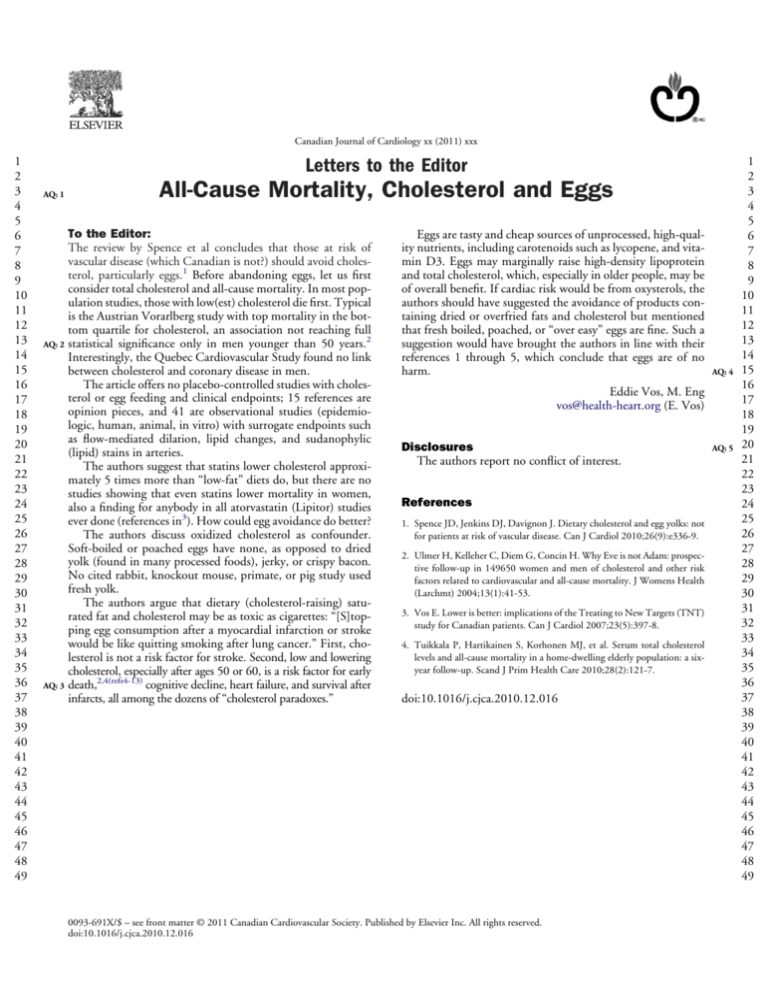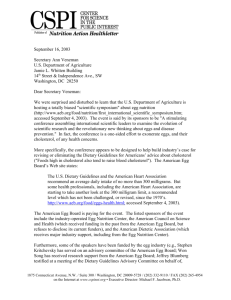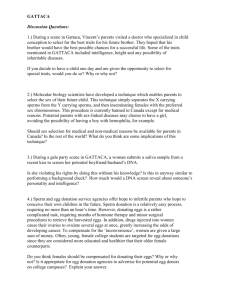
Canadian Journal of Cardiology xx (2011) xxx
1
2
3
4
5
6
7
8
9
10
11
12
13
14
15
16
17
18
19
20
21
22
23
24
25
26
27
28
29
30
31
32
33
34
35
36
37
38
39
40
41
42
43
44
45
46
47
48
49
Letters to the Editor
AQ: 1
All-Cause Mortality, Cholesterol and Eggs
To the Editor:
The review by Spence et al concludes that those at risk of
vascular disease (which Canadian is not?) should avoid cholesterol, particularly eggs.1 Before abandoning eggs, let us first
consider total cholesterol and all-cause mortality. In most population studies, those with low(est) cholesterol die first. Typical
is the Austrian Vorarlberg study with top mortality in the bottom quartile for cholesterol, an association not reaching full
2
AQ: 2 statistical significance only in men younger than 50 years.
Interestingly, the Quebec Cardiovascular Study found no link
between cholesterol and coronary disease in men.
The article offers no placebo-controlled studies with cholesterol or egg feeding and clinical endpoints; 15 references are
opinion pieces, and 41 are observational studies (epidemiologic, human, animal, in vitro) with surrogate endpoints such
as flow-mediated dilation, lipid changes, and sudanophylic
(lipid) stains in arteries.
The authors suggest that statins lower cholesterol approximately 5 times more than “low-fat” diets do, but there are no
studies showing that even statins lower mortality in women,
also a finding for anybody in all atorvastatin (Lipitor) studies
ever done (references in3). How could egg avoidance do better?
The authors discuss oxidized cholesterol as confounder.
Soft-boiled or poached eggs have none, as opposed to dried
yolk (found in many processed foods), jerky, or crispy bacon.
No cited rabbit, knockout mouse, primate, or pig study used
fresh yolk.
The authors argue that dietary (cholesterol-raising) saturated fat and cholesterol may be as toxic as cigarettes: “[S]topping egg consumption after a myocardial infarction or stroke
would be like quitting smoking after lung cancer.” First, cholesterol is not a risk factor for stroke. Second, low and lowering
cholesterol, especially after ages 50 or 60, is a risk factor for early
2,4(refs4-13)
AQ: 3 death,
cognitive decline, heart failure, and survival after
infarcts, all among the dozens of “cholesterol paradoxes.”
Eggs are tasty and cheap sources of unprocessed, high-quality nutrients, including carotenoids such as lycopene, and vitamin D3. Eggs may marginally raise high-density lipoprotein
and total cholesterol, which, especially in older people, may be
of overall benefit. If cardiac risk would be from oxysterols, the
authors should have suggested the avoidance of products containing dried or overfried fats and cholesterol but mentioned
that fresh boiled, poached, or “over easy” eggs are fine. Such a
suggestion would have brought the authors in line with their
references 1 through 5, which conclude that eggs are of no
harm.
AQ: 4
Eddie Vos, M. Eng
vos@health-heart.org (E. Vos)
Disclosures
The authors report no conflict of interest.
References
1. Spence JD, Jenkins DJ, Davignon J. Dietary cholesterol and egg yolks: not
for patients at risk of vascular disease. Can J Cardiol 2010;26(9):e336-9.
2. Ulmer H, Kelleher C, Diem G, Concin H. Why Eve is not Adam: prospective follow-up in 149650 women and men of cholesterol and other risk
factors related to cardiovascular and all-cause mortality. J Womens Health
(Larchmt) 2004;13(1):41-53.
3. Vos E. Lower is better: implications of the Treating to New Targets (TNT)
study for Canadian patients. Can J Cardiol 2007;23(5):397-8.
4. Tuikkala P, Hartikainen S, Korhonen MJ, et al. Serum total cholesterol
levels and all-cause mortality in a home-dwelling elderly population: a sixyear follow-up. Scand J Prim Health Care 2010;28(2):121-7.
doi:10.1016/j.cjca.2010.12.016
0093-691X/$ – see front matter © 2011 Canadian Cardiovascular Society. Published by Elsevier Inc. All rights reserved.
doi:10.1016/j.cjca.2010.12.016
AQ: 5
1
2
3
4
5
6
7
8
9
10
11
12
13
14
15
16
17
18
19
20
21
22
23
24
25
26
27
28
29
30
31
32
33
34
35
36
37
38
39
40
41
42
43
44
45
46
47
48
49
Canadian Journal of Cardiology 27 (2011) 264.e5 www.onlinecjc.ca
Not All Eggs Are Created Equal: The Effect on
Health Depends on the Composition
To the Editor:
A recent review addressed the increasing tendency to accept daily
egg as optional in healthy diets, particularly in patients with or at
risk for vascular disease. It emphasized that “diet is not all about
fasting blood lipids,” but rather the post-prandial effects of high
cholesterol, ie, increased LDL oxidation (37% with 2 eggs/day),
increased post-prandial lipemia (following ⬎140mg cholesterol/
meal), and potentiated adverse effects of dietary saturated fat (ie,
bacon and butter, compared to egg consumed with salad oil). Eggs
may further induce inflammation per observed elevations of CRP
and amyloid A, with worsened macrophage accumulation in adipose tissue. The Physician’s Health Study showed a 2-fold increase
in CVD and all-cause mortality following onset of diabetes, and
that egg consumption independently increased rates of new-onset
diabetes.
It is worth noting that most of these deleterious effects could
be addressed by egg composition modifications. Two/day eggs
with reduced n-6 PUFA and increased n-9 MUFA and antioxidants (vitamin E, carotenoids, selenium) reversed egg-induced
increased LDL oxidation to levels of 2-4 eggs/week (Figure 1).1
One/day n-3 PUFA-fortified egg improved triglyceride and
HDL levels,2 ApoB:ApoA1 ratio, and fasting plasma glucose.3
Similarly, 2/day eggs modified for reduced n-6 PUFA and enhanced n-9 MUFA and antioxidants reduced fasting glucose
compared to 2/day regular western high n-6-PUFA eggs. Being
an effective antioxidant delivery system, as shown by increased
blood vitamin E and carotenoids,1 and the finding that n-3
PUFA-fortified egg also reduced CRP,4 suggests that “designer”
eggs may provide protection against oxidative stress, inflammation, and acute effects of high glycemic load, recently linked to
increased inflammation and reduced blood antioxidants, potentially associated with diabetes risk.
The above emphasize that not all eggs are created/prepared
equal, and further, egg is not purely cholesterol, but rather a
high nutritional value food with a unique capacity to transform
and concentrate protective nutrients (ie, DHA, antioxidants) that
can modify metabolic/physiological effects. Moreover, eggs’
high “satiety index” makes them an important candidate
against obesity, and much lower carbon footprint than
chicken, beef, or pork yields environmental advantages.
Designing protective compositions and preparation, ie, based
on advantageous Mediterranean/Greek-type eggs and dietary
principles – high n-3 PUFA, n-9 MUFA, and antioxidants, with
low n-6 PUFA – could significantly influence egg-related benefits
vs risks. Modifications more suited to requirements of subpopulations could differentially widen recommendations to accept vs
reject eggs. Most of us will benefit, though consumption may
remain advised against in some metabolically/genetically-sensitive
and/or hyperlipidemic individuals.
Niva Shapira, PhD, RD, Agr
nivnet@inter.net.il
References
1. Shapira N, Pinchasov J. Modified egg composition to reduce low-density
lipoprotein oxidizability: high monounsaturated fatty acids and antioxidants versus regular high n-6 polyunsaturated fatty acids. J Agric Food
Chem 2008;56:3688-93.
2. Maki KC, Van Elswyk ME, McCarthy D, et al. Lipid responses in mildly
hypertriglyceridemic men and women to consumption of docosahexaenoic
acid-enriched eggs. Int J Vitam Nutr Res 2003;73:357-68.
3. Ohman M, Akerfeldt T, Nilsson I, et al. Biochemical effects of consumption of eggs containing omega-3 polyunsaturated fatty acids. Ups J Med Sci
2008;113:315-23.
Figure 1. Lag-time to plasma LDL oxidation following low-egg (2-4/
week) or high-egg (2/day) regular high n-6 PUFA (HPUFA-Regular), high
n-6 PUFA⫹high-antioxidant (HPUFA-HAOX), or high n-9 MUFA⫹highantioxidant (HMUFA-HAOX) 3-week regimes (n⫽17)1. ⴱP ⬍ 0.01 (vs.
low-egg); ⴱⴱP ⬍ 0.01 (vs. regular egg).
4. Burns-Whitmore B, Sapwobol S, Hadd E, Sabajaram S. N-3 fatty acid
enriched egg decreases C-reactive protein in healthy adults. FASEB J 2007;
21:704-5.
doi:10.1016/j.cjca.2010.11.010
0828-282X/11/$ – see front matter © 2011 Canadian Cardiovascular Society. Published by Elsevier Inc. All rights reserved.
Canadian Journal of Cardiology 27 (2011) 264.e1 www.onlinecjc.ca
Letters to the Editor
Eggs and Health Benefits
To the Editor:
Spence et al.1 send a strong message against eggs as the “target
food” for dietary cholesterol (DC). The purpose of my letter is
to draw attention to the published and well-established facts
regarding the effects of eggs on health.
A review of the current dietary guidelines for DC reports
that the European Union, Canada, India, Korea, New Zealand, and other countries have no guidelines regarding DC.2 In
contrast, there is a worldwide consensus limiting saturated fat
intake. Further, recent epidemiologic studies2 have demonstrated that there is no correlation between egg consumption
and coronary heart disease risk, which is not surprising given
that (1) eggs consistently increase high-density lipoprotein
(HDL) maintaining the low-density lipoprotein (LDL)/HDL
ratio3 even under conditions where LDL is not raised2; (2) eggs
contain lutein, a carotenoid known to protect against macular
degeneration,3 oxidative stress, inflammation, and atherosclerosis2; (3) eggs are a good source of choline, a key nutrient for
normal fetal development, which may also protect against Alzheimer’s disease4; (4) eggs suppress appetite and decrease caloric intake during the next 24 hours2; (5) eggs are nutrient
dense and an affordable source of high-quality protein5; and
(6) decreased egg consumption has been correlated with protein malnutrition in underdeveloped countries.
Spence et al.1 cite a study where the equivalent to 9500
mg/day of DC (1.25%) increases endothelial dysfunction in
mice. Other cited animal studies also used DC challenges not
related to human intake. In contrast, egg consumption is not
related to detrimental endothelial function.
Dietary recommendations should not be based on eliminating eggs, an excellent source of nutrients and other components
that provide benefits that extend beyond nutrition.
Maria Luz Fernandez, PhD
maria-luz.fernandez@uconn.edu
Disclosures
Dr Fernandez’s research on eggs has been supported by the
American Egg Board.
References
1. Spence JD, Jenkins DJA, Davignon J. Dietary cholesterol and egg yolks:
Not for patients at risk of vascular disease. Can J Cardiol 2010;26:e336-9.
2. Fernandez ML, Calle MC. Revisiting dietary cholesterol recommendations: Does the evidence support a 300 mg/d limit? Curr Atheroscler Rep
2010;12:377-83.
3. Fernandez ML. Dietary cholesterol provided by eggs and plasma lipoproteins in healthy populations. Curr Opin Med Nutr Met Care 2005;9:8-12.
4. Zeisel SH, da Costa KA. Choline, an essential nutrient for public health.
Nutr Rev 2009;67:615-23.
5. Drewnowski A. The Nutrient Rich Foods Index helps to identify healthy,
affordable foods. Am J Clin Nutr 2010;91:1095S-1101S.
doi:10.1016/j.cjca.2010.12.014
0828-282X/11/$ – see front matter © 2011 Canadian Cardiovascular Society. Published by Elsevier Inc. All rights reserved.
Canadian Journal of Cardiology 27 (2011) 264.e7–264.e8 www.onlinecjc.ca
Reply to Letters from Dr Maria Luz Fernandez,
Eddie Vos, and Dr Niva Shapira
To the Editor:
The letter of Dr Shapira rightly points out that the question of
cholesterol oxidation is related to what happens in vivo as much as
to what may occur in the frying pan, and that low-density lipoprotein (LDL) oxidation is part of the problem. It is worth remembering that elevated circulating cholesterol has deleterious pleiotropic effects that are exerted via LDL cholesterol (LDL-C) and
that may affect several physiological functions. Elevated LDL-C
has been associated with an increased atherogenic potential related
to enhanced susceptibility to oxidation (malondialdehyde modification), hypercoagulability (increase in beta-thromboglobulin,
thromboxane B2), enhanced platelet reactivity (increase in soluble
P-selectin, reduction of eNOS), reduced fibrinolysis (increase in
plasminogen activator inhibitor-1), endothelial dysfunction (reduced nitric oxide), increased vascular reactivity (increased thromboxane B2 and decreased prostacyclin), increased vascular permeability, and increased plasma viscosity (increased fibrinogen,
decreased erythrocyte deformability). It is also proinflammatory
(action on nuclear factor B, macrophages, and IL-1). The majority of these effects are improved by statins.1 It would be valuable
if the “improved egg product” alluded to shared several of these
beneficial pleiotropic properties besides the interesting antioxidant
effect. It is important to state, however, that simply giving antioxidant supplements, such as vitamin E, failed to offer protection for
coronary heart disease in a number of clinical trials, for example
the Heart Outcomes Prevention Evaluation study.
Eggs are clearly not all the same. The Canadian Nutrient
File at Health Canada, accessible online at http://webprod.hcsc.gc.ca/cnf-fce/start-debuter.do?lang⫽eng, shows that a
jumbo chicken egg contains 237 mg cholesterol; a duck egg,
619 mg; and a goose egg, 1227 mg. Eggs from chickens fed flax
seed have a higher content of omega-3 fatty acids; however,
their cholesterol content is similar to that of other chicken eggs.
For patients at risk of vascular disease, it would be better to eat
the flax seed and leave the egg cholesterol out of the issue.
Mr. Vos is right about two things: (1) Most Canadians
are at risk of vascular disease—the only ones who could eat
egg yolk regularly with impunity would be those who expect
to die prematurely from nonvascular causes, and (2) it
would be good to have a randomized clinical trial. A feasible
design would be to randomize vascular patients to consume
eggs or egg white– based substitutes, provided in identical
containers, with recipes for omelettes and frittatas, and follow these patients for cardiovascular events. We invite the
egg marketers to fund it and would be happy to conduct it.
We estimate that the costs would be approximately equivalent to their annual costs of advertising.
Unfortunately, Mr Vos confuses fasting serum cholesterol levels with the effect of dietary cholesterol. The more
important issue is the postprandial effects of consuming
cholesterol, including egg yolk. Focusing on fasting serum
cholesterol levels misses the bulk of the problem. Even
though serum cholesterol rises very little after a meal, dietary
cholesterol increases the susceptibility of LDL-C to oxidation, vascular inflammation, oxidative stress, and postprandial hyperlipemia and potentiates the harmful effects of saturated fat, impairs endothelial function, and increases
cardiovascular events (all referenced in our paper). Some of
these effects may be related to consumption of oxidized
cholesterol, taken up into LDL. Egg yolk consumption also
decreased by half the postprandial clearance of atherogenic
chylomicron remnants.2
Not only cardiovascular mortality,3 but all-cause mortality
(Strandberg et al 2004) is clearly related to elevated serum
cholesterol levels, in a graded fashion. Lower serum cholesterol
levels in cachectic patients with cancer likely explain reverse
associations with all-cause mortality in some studies. The effect
of cholesterol levels on stroke risk was for many years obscured
by the overwhelming effect of uncontrolled hypertension; in a
community where blood pressure was controlled, serum cholesterol was a significant risk factor for stroke.4 In the Stroke
Prevention by Aggressive Reduction in Cholesterol Levels trial,
among patients with carotid atherosclerosis, statin treatment
reduced recurrent stroke by 33%.5 Amarenco has shown clearly
in meta-analyses that statins reduce stroke risk.
People at risk of vascular disease (indeed, as Mr. Vos points
out, most Canadians) should not regularly consume egg yolks.
As discussed in Spence’s book, How to Prevent Your Stroke
(Vanderbilt University Press, 2006), they should learn to make
a delicious omelette or frittata using egg whites or egg white–
based substitutes such as Egg Beaters, Egg Creations, or in the
United States, Better’n Eggs. As eggs are required to make these
substitutes, the egg marketers would serve us all better by promoting healthy consumption of egg whites rather than dangerous consumption of yolks. For those wishing to lower serum
cholesterol levels, tofu scrambler (Amy’s Kitchen, Petaluma,
CA) is a useful substitution for scrambled eggs since soy consumption per se may lower serum cholesterol.
It is curious how Dr Fernandez, like many others, simply
doesn’t want to look at the evidence. We summarized clearly
the evidence that cholesterol has a permissive effect on, and
amplifies the effect of, saturated fat. Dietary cholesterol clearly
increases coronary risk. The same large, frequently cited studies
that showed no harm from egg yolks among participants who
remained healthy showed that egg yolks doubled coronary risk
among participants who became diabetic during follow-up.
The apparent absence of harm from egg yolks among people
who remained healthy during the period of observation is probably an issue of statistical power.
J. David Spence, MD, FRCPC
dspence@robarts.ca
David J. A. Jenkins, MD, PhD, FRCP
Jean Davignon, MD, MSc, FRCPC
0828-282X/11/$ – see front matter © 2011 Canadian Cardiovascular Society. Published by Elsevier Inc. All rights reserved.
264.e8
Disclosures
The authors have no conflicts of interest to disclose.
References
1. Davignon J. The cardioprotective effects of statins. Curr Atheroscler Rep
2004;6:27-35.
2. Cesar TB, Oliveira MR, Mesquita CH, Maranhao RC. High cholesterol
intake modifies chylomicron metabolism in normolipidemic young men. J
Nutr 2006;136:971-6.
3. Menotti A, Lanti M, Kromhout D, et al. Homogeneity in the relationship
of serum cholesterol to coronary deaths across different cultures: 40-year
Canadian Journal of Cardiology
Volume 27 2011
follow-up of the Seven Countries Study. Eur J Cardiovasc Prev Rehabil
2008;15:719-25.
4. Hachinski V, Graffagnino C, Beaudry M, et al. Lipids and stroke: a paradox
resolved. Arch Neurol 1996;53:303-8.
5. Sillesen H, Amarenco P, Hennerici MG, et al. Atorvastatin reduces the risk
of cardiovascular events in patients with carotid atherosclerosis: a secondary
analysis of the Stroke Prevention by Aggressive Reduction in Cholesterol
Levels (SPARCL) trial. Stroke 2008;39:3297-302.
doi:10.1016/j.cjca.2010.12.013









